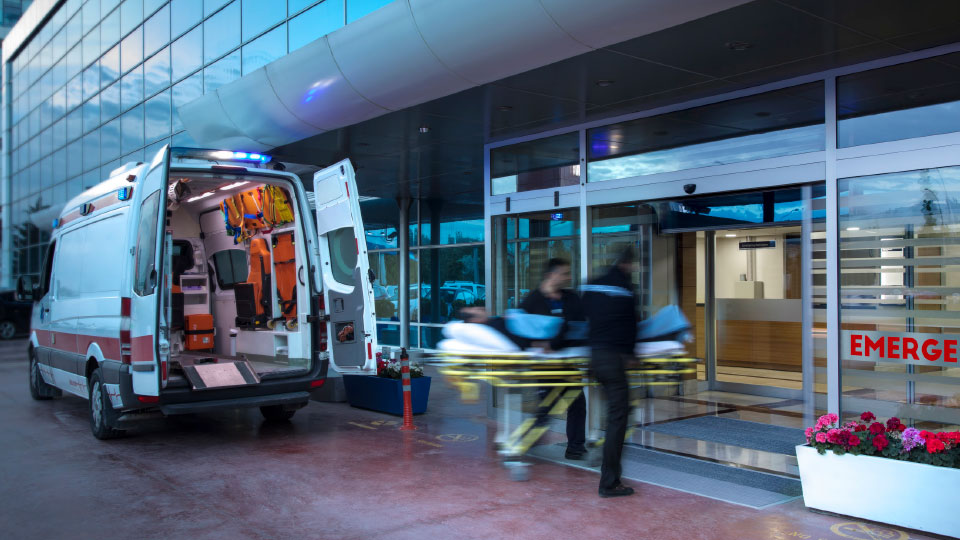Safe and Sound: A Primer on Audio and Intelligent Communications Applications for Security
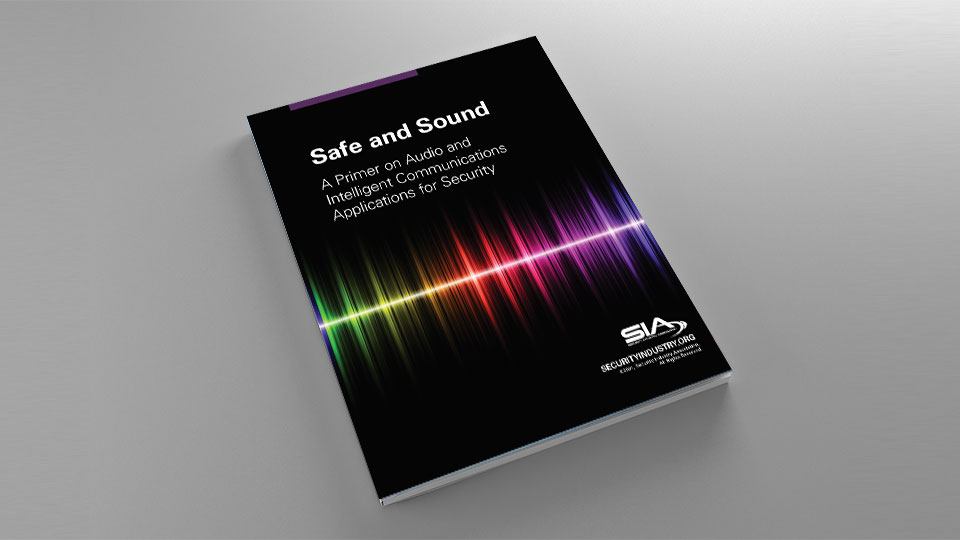
Table of Contents:
- Executive Summary
- Introduction: The Changing Dynamics of Audio and Voice Communications
- A Brief History of Audio Use in Security
- The Benefits of Audio: The Volume Is Increasing
- Audio Technologies and Applications
- Case Study: How Audio Can Make Schools Safer
- Case Study: Health Care Aces the Hearing Test
- Legal and Privacy Consideration
- Conclusion
Executive Summary
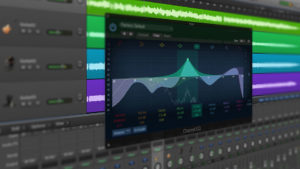 This informational guide is presented by the Security Industry Association (SIA) Audio & Intelligent Communications Working Group.
This informational guide is presented by the Security Industry Association (SIA) Audio & Intelligent Communications Working Group.
As the vendor-neutral technology working group representing the entire audio and intelligent communications ecosystem, the mission of SIA’s Audio & Intelligent Communications Working Group is to educate the industry to the importance of audio and communications and aid in growing this technology segment by providing business insights into the importance of audio for safety and security applications. We believe audio will be the central hub and is critical for control and intelligence within safety and security ecosystems.
This primer on audio and intelligent communications for security applications is intended to provide an overview of the common technologies and applications for those technologies. As a primer, it is particularly relevant for those with limited experience using audio and communications solutions in security and safety applications, and is written to be valuable for security practitioners, specifiers, consultants, security systems integrators and even business owners who are thinking about how they can use audio to protect their people and property.
This report covers common existing technologies such as intercoms, loudspeakers and microphones in addition to emerging technologies like gunshot detection and advanced multisensor audio analytics. It concisely presents how these audio solutions are necessary for improving response time, driving situational awareness and aligning with business goals of optimization and efficiency. In the paper, we also explore the legal and privacy considerations of using audio listening and monitoring solutions and dispel some of the common myths about the use of audio solutions.
Today, the audio and intelligent communications technology segment is poised for strong growth – driven by AI and machine learning algorithms that are pushing the limits of audio analytics, advanced by voice control that leverages natural language processing and powered by networked and IP-enabled microphones, speakers and audio processing and control software. As these technologies further develop and adoption increases, we believe that all need to hear the important message of why sound and communications are so vital for safety and security.
On behalf of the SIA Audio & Intelligent Communications Working Group, we hope that you find value in this report. If you share our mission, we invite you to participate by contacting us via our webpage and expressing your interest. This will no doubt be the first of many resources the group provides as we sound the word on the value of audio – and we hope you join us on this journey!
Introduction: The Changing Dynamics of Audio and Voice Communications
The 21st century has wrought changes that challenge our accustomed way of doing things in many facets of our lives, from increased security screening at airports to the way we communicate with each other – and, most strikingly, our ability to now communicate with the devices and appliances that surround us. We video chat, ask our refrigerators what we need to buy at the grocery store, tell our cars that we need directions and verbally ask our mobile phones questions about almost any topic under the sun.
Our increasing comfort level with audio and voice communications is also changing the way we view and enhance security in settings as diverse as manufacturing, offices, schools and even car dealerships. As the security industry adapts to and adopts emerging technologies that make our world a safer place, audio and intelligent communications are poised to deliver integrated and comprehensive solutions that are seen and heard today as a critical component of any security system.
Hearing Is Believing

Hearing is key to everything we do as human beings. We often hear something before we see it, as with gunshots, loud voices or breaking glass. Such sounds trigger a response that impel us to act, whether we reach for a dustpan and broom or dial 911.
Sound drives the initial response. In a security setting, sound that accompanies video gives responders so much more information and creates better situational awareness. Consider a guard who is monitoring video cameras. What that guard sees may not comport with the situation on the ground. For example, watching someone running tells you only so much. But if that person is screaming in fear as they run, the guard knows how best to respond. Hearing is believing.
Audio also acts as a force multiplier when integrated into a security system and can take safety, security and business operations to the next level – even allowing for de-escalation of some situations before they become events.
A Brief History of Audio Use in Security
Audio is not new to the industry, and applications have been deployed in many different settings, including hospitals, schools, law enforcement and commercial and enterprise facilities. And for more than a decade, audio has been offered as a standard feature in video cameras. End users have deployed loudspeakers, intercoms, two-way radios and duress buttons, all excellent communication devices, but in the past, such devices have been operated in silos. More importantly, many of these communication devices offered only one-way communications in situations that would benefit from two-way conversations, or they required intermediary action that slowed response times. In one example, pressing a duress button alerted security personnel to a developing situation, but without the ability to hear exactly what is going on, staff may have overreacted or underreacted. What if someone depressed the duress button accidentally? What if a perpetrator pressed the button as a distraction? This is clearly a case where integrated audio and video now proves extremely useful.
What has been missing is a holistic approach to addressing security through the integration of audio and intelligent communications with other systems, including video cameras, access control and intrusion detection. The reasons for this not being a standard for security systems are many, but two key reasons stand out. Traditionally, audio communications have been based on analog devices with no straightforward way to tie them into a security system. The complexity of adding audio to existing and different infrastructures could be costly. Today, transitioning from analog to digital audio solutions is much easier. One reason for the increased is that the network has become the backbone for data capture, communications and security in government, commercial, educational, health care and even home environments. The second reason is that most IP-networked audio solutions are software based, making them much more flexible and scalable.
The shift to IP-based microphones and speakers makes integration more cost-effective, as audio solutions now run on the network. Unfortunately, there remains one significant misperception around audio that is holding it back from widespread adoption – that audio solutions are, or can be, illegal. We will address this misperception and misunderstanding of state and federal law in more detail as our story progresses.
Intelligent communications, the analytic side of audio, have been in use for many years. The first uses of audio analytics were basic and focused on listening for an increase in decibel (dB) level. If the dB level passed a certain level, an alarm sounded. The big disadvantage was a substantial number of false positives because there was no distinguishing between different sounds. An airplane flying overhead triggered an alarm as surely as a gunshot did. That has all changed dramatically and positively, driven in large part by end user demand.
Customers with varied needs started asking the same type of questions regarding audio and audio analytics in the early 2000s. Can you detect aggression in people’s voices in the city’s nightlife area? Can you detect aggression in prisoners’ voices? Can you detect aggression in passengers’ voices as they interact with train conductors? The answer to these questions led to the use of audio analytics in a wide range of security applications which have evolved from there.
Another new development has been the use of artificial intelligence to look at patterns in different frequencies. Now, instead of only analyzing dB level over time, audio analytics can distinguish patterns in different frequencies leading to the reliable identification of aggression in people’s voices, gunshots or glass breaking. In health care settings, audio analytics can distinguish among medical device alarm tones and can alert nursing staff to potential health concerns via audio signatures of coughing and even snoring.
The most recent innovation in audio analytics is the introduction of multisensor awareness. This means that multiple sensors, working together, help determine whether that sound just heard was an actual gunshot or a false positive. In the future, we see that combining audio metadata with video metadata and other data sources (weather, social media, etc.) can lead to better trend analysis and predictive systems that can make autonomous decisions.
The Benefits of Audio: The Volume Is Increasing
The adoption of audio and intelligent communications for security applications is growing. Societal and technological changes and advancements are contributing to this increasingly dynamic growth. Amazon’s Alexa and Apple’s Siri, two of the most common voice assistants, have joined the ranks of other consumer electronic devices and household appliances as ubiquitous presences in many homes. A report by Juniper Research estimates that sales of smart audio devices will top $10 billion in 2022.
Everyday use of sound capture has become commonplace and accepted in many areas, even within the justice system. A recent event in California demonstrates this broad acceptance. A shooting in a grocery store parking lot was captured on security video while a nearby doorbell camera picked up the audio of the gunshot. Law enforcement was able to synchronize the sound occurrence with the video through time stamps on both audio and video recordings, and a judge admitted that footage synchronization into evidence.
In security specifically, new capabilities in audio technology, including improved audio analytics, are driving demand. The 2020 Security Business Magazine State of the Industry Report shows that 18% of integrators added audio detection to their suite of security solutions. Coupled with a growing recognition on the part of end users of the value of audio detection, the segment is poised for phenomenal growth in the years to come.
Car dealerships’ experiences in controlling damage and theft to vehicles on their lots illustrates why end users are increasingly adding audio to their security programs. More than 700,000 vehicles are stolen in the United States every year, and four out of 10 of these thefts occur at car dealerships. While many dealerships use video cameras, simply adding audio capabilities can produce significant rewards. Typical are the experiences of dealerships today that have combined microphones and speakers with existing camera systems to actively monitor and remotely communicate with persons in areas where new and used vehicle inventories can be the target of theft and vandalism. Integrating audio and video has helped dealerships reduce such incidents by 90% in many cases.
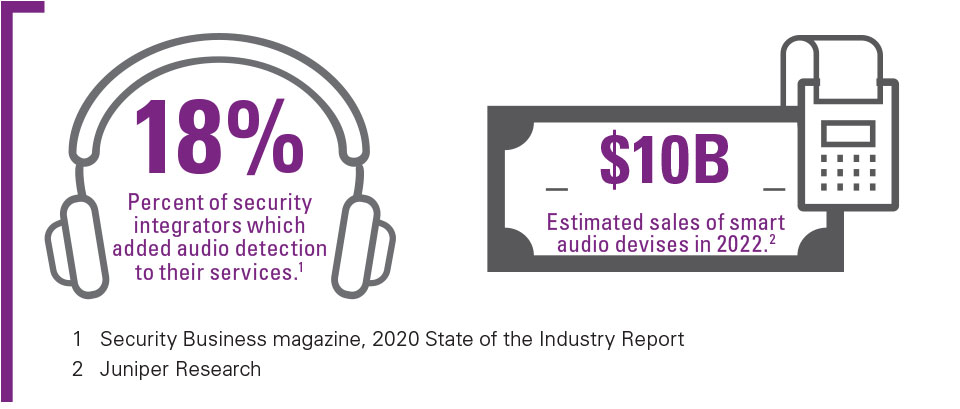 The benefits of integrating audio and intelligent communications are varied and many and can best be demonstrated by examples such as the one above. Applications are often highly customized and span the gamut of processes, procedures and desired outcomes, from operational efficiency to compliance requirements to life, safety and security improvements. The following is a more detailed discussion of those benefits.
The benefits of integrating audio and intelligent communications are varied and many and can best be demonstrated by examples such as the one above. Applications are often highly customized and span the gamut of processes, procedures and desired outcomes, from operational efficiency to compliance requirements to life, safety and security improvements. The following is a more detailed discussion of those benefits.
 Response Time Improvement
Response Time Improvement
A reduction in response time can potentially prevent a verbal altercation from morphing into a physical brawl, or at least provide an opportunity to intervene early before extensive physical or mental harm or loss of life occurs. One school was able to reduce its response time to fights among students from two to three minutes, during which time much damage could be inflicted, down to 20 to 30 seconds – a reduction of 75% in response time! Microphones picked up shouting, analytics detected aggression and alerted school resource officers (commissioned, sworn law enforcement officers) who responded in real time.
Response times can also be improved for remote areas when audio and alert systems are powered by software that is on a mobile phone. Being able to connect by mobile phone to the audio software further frees the security or response team from depending on two-way radios, telephones or microphones, which may be back at a command center, security station or in a vehicle.
 Improved Situational Awareness
Improved Situational Awareness
Improved situational awareness leads to more appropriate and proportional responses to situations. This means getting staff as much information as possible, in meaningful ways, so they can make the right decisions as to how to respond. Audio amplifies awareness leading to a more appropriate response and improved outcomes.
An excellent example is the incorporation of audio into an intrusion detection system that allows a human to listen to live audio from the scene in real time. This additional information helps the security officer to better understand what exactly is happening at the event location. That officer, armed with this additional and critical information, can determine if the event is real and notify public safety for immediate dispatch.
Integrating a camera with a microphone can also give staff access to more details about a suspect or a scene including languages spoken, names uttered or directives given. This additional data can also prove crucial for first responders in assessing a suspect’s intentions and threat level. Add a speaker along with that camera microphone, and security teams can then have a two-way conversation to potentially de-escalate the situation or at a minimum, make those in the vicinity aware of an imminent response by the security team.
Furthermore, when someone hears an unexpected voice from a speaker in an area, the first thing they often do is look to see where it’s coming from. If a camera is present, the camera can visually capture who the individual is, which gives the operator additional situational awareness for knowing how to respond, whether by asking additional questions or sending assistance.
 Operational Efficiencies and Business Optimization
Operational Efficiencies and Business Optimization
Adding an audio solution to a security system can deliver operational efficiencies by eliminating manual processes and streamlining reporting requirements. Answering the questions when, where, why and how is simplified as an integrated system provides a clear audit trail with details relating to these questions. Staff no longer need to seek out the answers from different people and systems.
From a business optimization perspective, audio offers a proactive rather than reactive solution. Integrated with surveillance cameras and access control systems, audio delivers more comprehensive and intelligent information. Communication among these components offers genuine insight into the risks associated with potential security breaches. As audio systems aggregate more data, they yield higher statistical awareness and provide greater accountability and increased intervention and prevention capability.
Two real-world examples of how sound can optimize business outcomes highlight the diverse security applications that audio provides. In one instance, integrated intercoms at entrances eliminate the need for dedicated visitor entry staff, allowing a central security office to handle such visitor entry.
In another real-world scenario, the operator of one of the largest parking garages in the world (located in the United States) added a micro-switch behind the fire extinguishers it was required by code to install in the parking garage. When the fire extinguisher was removed, it automatically opened an audio channel back to the security operations center, where in turn security was able to advise the person who removed the fire extinguisher and call the fire department if it was needed. The parking garage operator saw a decrease in out-of-control fires (users often didn’t understand how best to use the fire extinguisher) and, as a bottom-line result, saw its insurance costs decline substantially.
 False Alarm Minimization
False Alarm Minimization
Audio and intelligent communications facilitate real-time confirmation of the validity of an alarm.
Real-world examples include hearing someone say they accidentally pushed the duress button or hearing the meowing of a cat when a motion detector has been activated.
Verifying alarms provides significant cost savings both in reducing fines and eliminating unneeded responses.
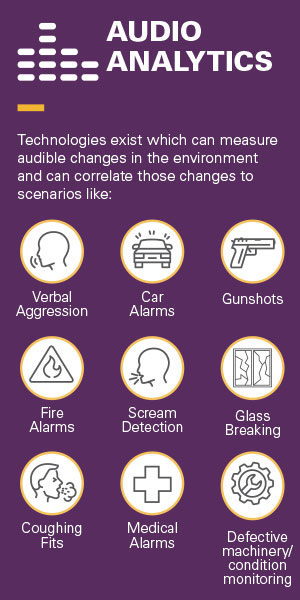 According to the U.S. Department of Justice, more than 90% of emergency alarms are unnecessary for one reason or another and pose a serious threat to police department effectiveness and public safety. False alarms pose another danger in that repeated occurrences may result in complacency on the part of security staff and responding law enforcement.
According to the U.S. Department of Justice, more than 90% of emergency alarms are unnecessary for one reason or another and pose a serious threat to police department effectiveness and public safety. False alarms pose another danger in that repeated occurrences may result in complacency on the part of security staff and responding law enforcement.
According to the International Association of Chiefs of Police (IACP) 2020 Model Ordinance for Alarm Management and False Alarm Reduction, a verified alarm is defined as an “electronic security system event in which a trained central station operator” using a standard protocol determines the presence of human(s) and a high probability that a crime is taking place.
A key element of the IACP’s Model Ordinance is the requirement for using The Monitoring Association’s ANSI CS-V-01 standard to verify an alarm before requesting a law enforcement response.
The standard calls for the use of audio, including two-way communication systems and listen-in one-way audio to verify alarms as well as video or smart device verification.
 Return on Investment
Return on Investment
There are numerous examples of increases in security efficiency in this report, from school security response times to securing car dealerships. Today, however, many security solutions are being recognized for the value they can provide outside of a typical security application.
One example is in health care settings, where audio solutions are analyzing medical device alarm tones and sending alerts to nursing staff when something is not right, thus saving time, money and even lives. For example, hospital bed exit alarms are tripped if a patient who has an elevated risk of falling tries to leave the bed (according to the Joint Commission Center for Transforming Healthcare, the average cost of a hospital fall with injury is approximately $14,056). A nurse responding to such an alert can not only save the patient from harm but also save the facility from potential monetary liability.
In the oil production industry, audio solutions have been tapped for emerging applications to trigger alerts and help engineering teams identify machinery in need of servicing, thus avoiding what could be millions of dollars of cost in unanticipated repairs and production facility downtime.
In conclusion, in a cost-benefit analysis of adding audio and intelligent communications to a security system, the savings are realized not only in lowering damage, security, insurance and administrative costs, but also can be used to increase efficiency and deliver savings in core business areas.
 Remote Communication
Remote Communication
Integrating audio and video proves its value and importance in a wide range of applications, never more so than in remote communication. Many of today’s video management systems (VMS) have analytics built in that provide information about sites that are far removed from the security operations center.
For example, breaches of preset perimeters at remote locations can trigger alerts within the VMS, but without audio, the ability to address the situation relies on a physical response. While this response may be required, the time it would take a security officer to arrive on scene may mean the inability to mitigate or prevent a dangerous situation. With an integrated system, once a camera detects motion at the remote site, the VMS can send the audio system a message to release a prestored, prevetted “voice down” warning miscreants that the area is under surveillance and that the proper authorities have been notified and are en route.
 Mass Notification/Wide Area Communication
Mass Notification/Wide Area Communication
The value of an integrated audio communications systems proves its value in diverse applications. Mass communications and the ability to intervene remotely in a developing situation demonstrate the efficacy and importance of such capabilities.
In the event of an active shooter on the premises, preset “voice down” serve the same function as in the remote site example, but in this case alerting those in harm’s way to take shelter. Consider also a situation that might be diffused by simply communicating with a belligerent party and asking them to back down. Now, consider not having the option and sending law enforcement to the scene. A risky face-to-face confrontation looms that can lead to unintended consequences. With audio confirmation of developing events, if first responders are dispatched to the scene, they will be better prepared to deal with the situation and take precautionary measures, if necessary.
 Analytics: Edge and Cloud Options
Analytics: Edge and Cloud Options
Providing analytics at the edge supports many of the other benefits associated with integrating audio and video. With the processing power in cameras, intercoms and standalone audio devices growing, they have been transformed into detection devices rather than mere sensors capturing data for evidentiary purposes. While most analytics tend to be moving to the edge, server-based (on-prem and cloud) options do exist, as do hybrid approaches that leverage software and edge processing.
Advantages of edge processing:
- Less cost due to limited need for centralized servers
- No single point of failure for all audio processing
- Can increase privacy by locking down the edge device so that audio doesn’t leave the devices, only the alerts do
- Can save bandwidth if no continuous streaming is required
Advantages of centralized processing (on-prem or cloud):
- Can make increased processing power available
- Centralized ability to upgrade analytics and features
- Benefits for scalability in storage
 Two-Way Communications
Two-Way Communications
While sirens and strobe lights are effective devices at warning folks in public places that something is wrong, they are unable to provide specific instructions as to what to do, where to go and how near the danger is. Whether it’s a weather event, a fire or active shooter, audio allows for specific instructions to be delivered as an event is occurring, potentially saving lives.
Using two-way communications, such as intercoms, speaker microphones, emergency call boxes or blue-light emergency phones (most often used on college campuses) and talk-listen outdoor monitors, in security monitoring applications can also help ensure accountability. For an added layer of security, an access control-integrated intercom can provide secondary verification of visitors to a facility.
Higher Perception of Safety Among Staff
In these days of low unemployment, retaining competent staff is crucial to business operations in any industry. Work environments that present challenges to safety and security, such as schools, hospitals and even restaurants and retail stores help employees feel safer when audio is an integral part of the security program.
Take the example of a hospital emergency room, where workplace violence is a huge problem. In fact, 75% of all workplace violence takes place in health care settings according to The Joint Commission’s 2018 report “Physical and verbal violence against healthcare workers.”
If medical staff need to push a panic button or call for security, the chances are that the situation may already be out of hand. Now consider that the video cameras are integrated with audio and audio analytics. Staff monitoring the video and hearing exactly what is happening can be at the scene before medical personnel even think to hit the panic button or call for help if they even can.
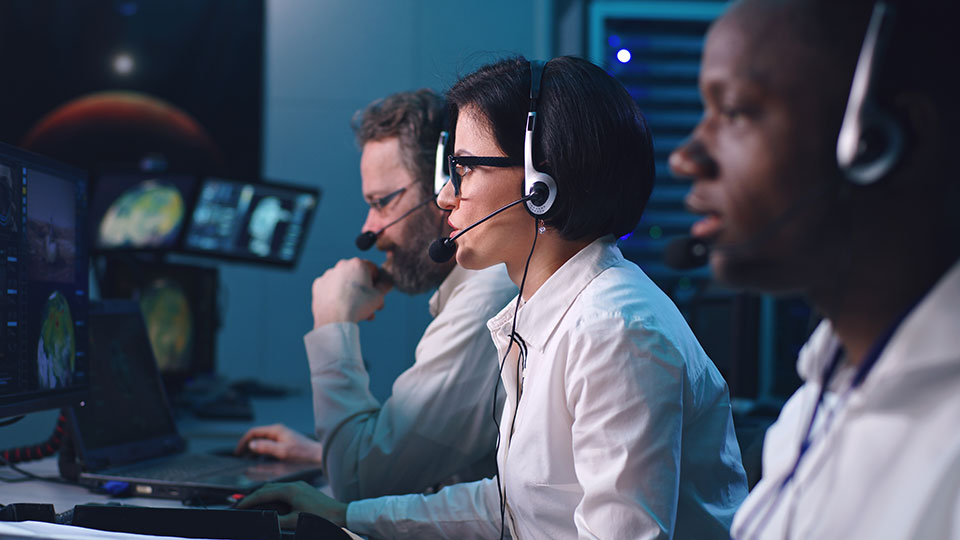
Adding audio and intelligent communications to the suite of security solutions deployed in the SOC is not only a force multiplier but also offers a host of other benefits.
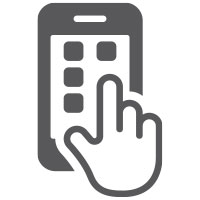 Audio in the Command Center/Security Operations Center
Audio in the Command Center/Security Operations Center
Many businesses operate security operations centers (SOCs), especially those with large campuses and/or satellite locations. Adding audio and intelligent communications to the suite of security solutions deployed in SOCs is not only a force multiplier but also offers the host of other benefits already discussed, including instant situational awareness.
We have all seen what such control rooms look like, if only on TV shows or in the movies, which are not far from reality. What’s also real is the potential for the SOC operator to be temporarily distracted or overwhelmed, especially when having to monitor some 20 to 30 video camera feeds.
Distractions may come in many forms, not least from our cell phones, with their near-constant beeping and chirping. Thus, a security officer’s attention may be temporarily diverted from the screens being monitored, and in those few minutes a situation that warrants immediate attention is missed. In a fascinating 2014 study, the authors found that despite focusing our attention on the task at hand, we often find ourselves unable to block out irrelevant distractions (such as the ping of a new text or email message you might receive while reading this report).
Cue the audio. With integrated audio, access control and video systems and the use of analytics, an audible alert draws attention to a developing situation. Gunshots, movement, screams or aggressive speech will trigger such alerts in the system, and they will sound in the SOC, where most emergency communications originate. So, despite the security officer’s momentary distraction, an audio alert will draw their attention to the relevant scene, often showing a message as to exactly what is occurring, e.g., gunshot detected.
Integrated security systems that include audio, video and access control also benefit operators in a SOC, as they can control building loudspeakers and fire alarm notifications to alert occupants. Depending on the system’s features, you may also be able to integrate a two-way radio or intercom, providing even more flexibility for SOC staff in determining the quickest way to respond to an emergency. And with preset, prerecorded messages, all of this can happen with the touch of a button.
Audio Technologies and Applications
 Getting Down to Basics
Getting Down to Basics
Integration is everything. Analytics are the glue that ties it all together. Two concepts common to the effective use of audio and intelligent communications in a comprehensive and effective security solution. Business processes related to risk, resilience and security will be fully optimized when the underlying systems – access control, video surveillance, audio and intrusion detection – are integrated and interoperable.
Listening intelligently helps security and law enforcement personnel define which acoustic events are relevant and demand a response versus those that are either a nuisance or normal. Analytics works in much the same way as the human ear processes sound. When an audio signal comes in, the sound detection software analyzes the noise based on advanced algorithms and determines whether it is a match for other sound patterns from preclassified sources.
Once the system identifies the sound as a positive detection, the software sends an immediate visual alert to security staff through the video management system. The system can also trigger an alarm. All of this happens within seconds of a sound being heard.
In this section, we will examine the fundamentals of audio technology as well as specification considerations. There is also an overview of current applications of audio devices such as emergency call boxes, speakers, intercoms, gunshot detection and sensors. A discussion of emerging applications, often accelerated by the pandemic, includes remote security operations centers and remote guarding and crowd management.
As noted, the security industry has used audio technology for many years, although those systems were analog and siloed operationally. Fast forward to the present day, where audio is fast becoming an integral part of a comprehensive security system in newly integrated ways.
Speakers
Microphones
Emergency Call Boxes
Intercoms
Gunshot Detection
Gunshot detection is all about public safety. According to the 2020 State of the Industry Report, 28% of respondents were interested in adding or already added gunshot detection to their product offerings. As an early warning system, gunshot detection has the potential to mitigate dangerous situations, giving first responders as much information as possible and as quickly as possible. That information includes where the gunshot was detected, shortening the response time even more. As this technology advances, triangulation is being used to determine the location where shots have been fired more precisely.
 Applications Outside of Normal Security Uses
Applications Outside of Normal Security Uses
As versatile as audio is, deploying it in contexts outside of security can deliver tremendous benefits in a variety of settings, most notably in health care settings. So, while offering health care facilities a comprehensive security solution that includes audio, consider how that audio might enhance other hospital operations, especially in a COVID environment. Today, hospitals are using two-way communications to lessen the time they need to interact personally with patients who have contracted an infectious disease. Aside from protecting front-line workers such as nurses, the need for personal protective equipment is lessened.
Using audio devices, nursing staff can also remotely monitor patients and the devices that are monitoring patients. Here again, audio analytics have advanced to such a degree that companies have trained the analytic on alarm tones from medical devices and coughing or stressed voices. A priority alert can alert nursing staff if a ventilator hose is disconnected, if a patient who is at risk of falling is exiting their hospital bed or if a patient is experiencing a coughing fit.
Life safety applications extend to the use of speakers to alert building or campus occupants of an approaching storm or tornado, advising as to when and where to take shelter. Another potentially life-saving application is in the use of emergency call boxes that today often have colocated defibrillators, or AEDs, so if you pull out the AED, it activates a micro-switch which automatically opens an audio channel to
a security monitoring center.
This is especially useful on sprawling business or educational campuses where a heart attack or stroke may occur without warning. As many of us are not skilled in the use of such devices, instruction delivered in the moment from a knowledgeable source in the monitoring center can make a meaningful difference. At the same time, the operator can dispatch first responders to the scene.
In retail settings, audio can be used to control wait times at checkout or deliver tailored messages in specific areas. For example, retailers can deliver audio messages at entrances, reminding arriving customers that masks are required, informing them of specials available in store that day or, at intervals, reminding them to maintain social distancing.
In some retail applications, combining audio with video has helped reduce shoplifting and in-store face-to-face confrontations with security staff. For example, video captures shoplifters in action. Security monitoring the video can use audio via a speaker system to inform the shoplifters that they are being watched and that security is on its way. One retailer was able to dramatically lessen incidents of shoplifting using such an integrated solution.
Perhaps the area where audio has delivered significant benefits that are not security-related per se is in law enforcement’s use of audio in interview or interrogation rooms. Immediate interviews with witnesses or interrogations of suspects can yield compelling spoken evidence for the prosecution to present to a jury.
In such situations, video by itself is not of much value to the prosecution, but a verbal confession that the judge and jury can hear can prove invaluable. Microphone-speaker combinations work well for law enforcement, especially when the system can be muted to preserve attorney-client privilege in an interview or interrogation room.
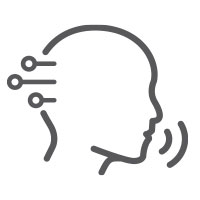 The Future of Audio and Intelligent Communications
The Future of Audio and Intelligent Communications
Industry experts agree. The future of audio and intelligent communications has only just begun and, in some cases, is already here. Witness the integration of audio with mobile devices. Today, a security guard on foot patrol can tap into speakers installed in a sprawling parking lot (if there is Wi-Fi access) and deliver a message to intruders some distance away faster and more safely than going there – using only a cell phone.
As society grows more accustomed to using voice technology to communicate with everything from our refrigerators to our cars, the adoption of audio and intelligent communications for security will also grow. Advances in the technology such as improvements in analytics for noise reduction will facilitate such growth, as will emerging applications such as the ability to create virtual security officers.
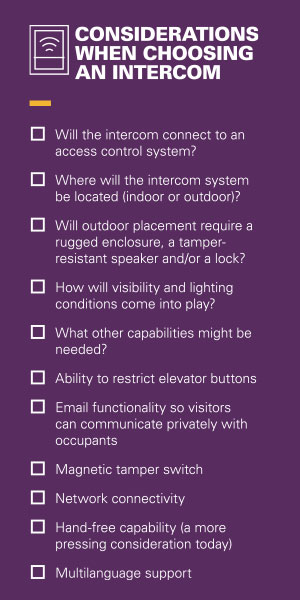 A virtual security officer needs both eyes and ears to be effective and the addition of audio to video delivers. An example would be the ability to communicate with a visitor who may have arrived at the wrong entrance and directing them to the correct location – without having to physically send a guard. Using audio allows for remote and interactive mitigation of many security situations that arise.
A virtual security officer needs both eyes and ears to be effective and the addition of audio to video delivers. An example would be the ability to communicate with a visitor who may have arrived at the wrong entrance and directing them to the correct location – without having to physically send a guard. Using audio allows for remote and interactive mitigation of many security situations that arise.
The growing use of artificial intelligence will also enhance the ability to communicate in real time as language translation, already advanced in voice assistants such as Cortana, Siri and Alexa, continues to advance. In a security setting, that virtual security officer could now communicate using their native tongue and have the message delivered in the recipient’s language.
Another potential advancement would be the use of an audio substation to replace a card reader so that one’s voice becomes their identity credential. As broader adoption leads to more intelligent use of the technology and its capabilities, audio will emerge as more of a standard as opposed to a should-have or nice-to-have. Speakers that offer more functionalities may be on the horizon as well, as some new players from the audio industry recognize the potential for audio in security applications.
The future also holds out the possibility of voice activation of security systems so that instead of pushing a button, a security officers speaks a command to release an emergency message or remotely open a door. The value of this approach would improve speed and performance and be easy to use, as we are now accustomed to speak commands to the devices that surround us.
On the intelligent communications side, there are already signs that analytics are moving toward being able to identify a broader array of sounds and events thus providing ever more targeted messages both in the alerts sent and communications sent over speakers. As noted above, artificial intelligence and machine learning is also playing a role in advancing the value of audio and audio analytics.
After installing microphones and using audio analytics, one school was able to reduce its response times from to to three minutes down to 20 to 30 seconds, a 75% reduction.
Case Study: How Audio Can Make Schools Safer
In 2019, 22% of students ages 12 to 18 reported being bullied at school according to the 2019 School Crime Supplement report. About 15% reported being made fun of, called names or insulted. Audio is uniquely positioned to capture these types and incidents and provide school administrators with the information needed for intervention and de-escalation.
Identifying instances of bullying can yield insights into who is doing the bullying and who is being bullied. This could prove crucial in preventing future acts of violence since most attacks at schools have been carried out by those who have been victims of bullying.
In a 2021 report titled “Averting Targeted School Violence,” the U.S. Secret Service (yes, they do more than protect the president), stated that “students were most often motivated to plan a school attack because of a grievance with a classmate.” Often, that grievance arises from being bullied.
Installing microphones at key traffic or intersection points provides accountability by documenting what is said, which can then be used to resolve disputes or placate verbally hostile individuals.
After installing microphones and using audio analytics, one school was able to reduce its response times from two to three minutes down to 20 to 30 seconds, a 75 percent reduction. This resulted in a drastic decrease in serious incidents, fewer visits to the school nurse and fewer calls from angry parents. An unexpected outcome was that the 75 fights the school thought occurred annually really was more like 100.
Because most of these incidents were happening in the same locations, school administration rethought the travel paths of students, including travel to and from classes and recess locations. The result: near elimination of aggressive behaviors among students in those areas.
For more information about the effective uses of audio in school settings, check out the Partner Alliance for Safer Schools (PASS) guidelines.
Health care settings, where emergencies are often a regular occurrence, benefit from an integrated and comprehensive security solution that listens, observes and reacts swiftly.
Case Study: Health Care Aces the Hearing Test
Audio in health care settings offers myriad benefits from staff safety to patient monitoring. According to findings from the U.S. Bureau of Labor Statistics, health care and social services workers experience the highest rate of injuries from workplace violence and are five times more likely to suffer a workplace violence injury than workers overall. The same report finds that health care workers accounted for 73% of all nonfatal workplace injuries due to violence in 2018.
There are many high-risk areas in health care settings where audio and audio analytics can reduce or mitigate the occurrence of violent events, from emergency rooms to parking structures.
A Florida hospital was experiencing a high number of verbal altercations that turned into physical violence in its emergency room. The hospital’s old way of dealing with these situations was either a panic alert button or a phone call, which often meant that security arrived too late to intervene and stop the violence. After switching to an audio analytic solution, the hospital has seen a vast reduction in serious incidents.
An additional and unanticipated benefit was the positive reviews that the security director received after the system was deployed.
“We received so many responses to our customer service poll that noted how the security team has become much more proactive and visible,” the director said. “They are in the right place at the right time.”
Aside from staff, visitor and patient security, audio and audio analytics can help with patient monitoring and safety while at the same time minimizing risks to staff from too much contact with contagious patients. Today’s audio analytic systems can distinguish among medical device alarm tones, alerting staff to critical alarms or malfunctioning equipment such as a ventilator hose becoming disconnected.
Emergencies can develop in unanticipated ways so having eyes and ears ready to discern what is happening can mean the difference between a good outcome and a negative one. Health care settings, where emergencies are often a regular occurrence, benefit from an integrated and comprehensive security solution that listens, observes and reacts swiftly.
Legal and Privacy Considerations
As mentioned earlier, concerns about the legality of using audio in security applications, specifically microphones, has restrained adoption of this vital technology. Understanding why such applications are legitimate begins with an understanding of current uses and the law. The following discussion does not constitute legal advice and when doubts arise about specific use cases it is best to retain legal help.
Let’s begin by looking at the relevant federal statute Title 18, United States Code, Chapter 119, Section 2511(2)(D), which states, “It shall not be unlawful under this chapter, for a person not acting under color of law to intercept a wire, oral or electronic communication where such person is a party to the communication or where one of the parties to the communication has given prior consent to such interception.”
In plain language, recording conversations where the parties are openly communicating, with no expectation of privacy, or at least one of the parties agrees to the recording, is legal.

That’s the federal statute; however, some states beg to differ. Currently, 11 states require that all parties to a conversation give their consent to being recorded. The rest of the states have “one-party” consent laws. All this means is that if you are a party to a conversation, you can record it. If you are not, you must obtain the consent of at least one party.
The U.S. Supreme Court has also weighed in, specifically on the issue of an expectation of privacy in public places. Most notable is the Supreme Court’s ruling in Katz v. United States in 1967, which expanded the Fourth Amendment’s protections to include as a constitutionally protected area “what a person seeks to preserve as private, even in an area accessible to the public.”
The Supreme Court further stated that the Fourth Amendment “protects people, not places,” therefore “what a person knowingly exposes to the public, even in his own home or office, is not a subject of Fourth Amendment protection. But what he seeks to keep private, even in an area accessible to the public, may be constitutionally protected.”
What does all of this mean for the use of audio solutions in security applications? This is a two-part answer that begins with letting people know that the area they are in, or entering, is under audio surveillance (and video surveillance). Transparency is key. Clearly visible and easy to read signage at retail store, commercial or government building entrances is necessary.
Consent, vital to privacy protections, is implied if the customer or citizen, after seeing the signage, continues into the area without reservation. There may be an exception to this because in some cases, an individual may not have a choice as to whether to enter or not. For example, a citizen who needs a government service. In such instances, their right to privacy may still be intact.
The second part of the answer relies on the concept of a reasonable expectation of privacy. For our purposes, if someone is yelling for help, no matter where they are, they want to be heard. The same is true for people who are yelling aggressively. They are not trying to be private but are trying to be heard. Hearing and recording aggressive or overly loud speech, whether by humans or with technology, would not constitute an invasion of privacy. Context matters when it comes to protecting human life or valuable assets.
Aside from signage, as an industry best practice, audio systems should not record sound continuously. In most cases, recording devices (NVRs) can temporarily buffer sound alongside video. Many systems can be set up to record what was buffered just before and after a detection of sound to allow security to verify the detection and preserve the video and audio for forensic evidence.
Transparency is a core privacy tenet. Signage alerting to the use of surveillance technologies is an important aspect of transparency but so is communicating with stakeholders – customers, citizens, employees, guests – who should hear how and why the technologies are being used. Sharing the reasons for the monitoring, that the audio solution will enhance overall safety and security, will reassure all that their privacy has been taken into consideration.
What Is the Katz Test?
In 1965, Charles Katz, a private citizen involved in sports betting used a public telephone booth (remember them?) near his home to communicate his bets to bookmakers in Boston and Miami. Unbeknownst to him, the Federal Bureau of Investigation (FBI) was using a covert listening device attached to the outside of the phone booth to listen to his conversations. The FBI then arrested Katz for illegally placing bets over the phone and between states, which is a federal crime.
The government convicted Katz based on the recorded conversations. His subsequent appeal went all the way to the U.S. Supreme Court. The court’s decision overturned Katz’s conviction, and the Katz test was born out of a concurring opinion which elaborated on the meaning of a reasonable expectation of privacy.
In that concurring opinion, Justice John Marshall Harlan stated that there were two parts to be satisfied in determining what a reasonable expectation of privacy entailed. First, that a person behaved as if they expected their words and actions to be private, and second, that the expectation is one that society at large would agree was reasonable. To quote Justice Harlan:
Thus, a man’s home is, for most purposes, a place where he expects privacy, but objects, activities or statements that he exposes to the ’plain view‘ of outsiders are not ’protected‘ because no intention to keep them to himself was exhibited. On the other hand, conversations in the open would not be protected against being overheard, for the expectation of privacy under the circumstances would be unreasonable.”
 Conclusion
Conclusion
The core DNA of any security technology platform relies on three key elements operating in tandem to prevent, detect, protect against, and document dangerous and potentially harmful behaviors and situations. From intrusion detection, perimeter security and access control systems to keep the bad guys out, to eyes on the ground with cameras and a video management system, to audio and intelligent communications to help make sense of out-of-the-ordinary occurrences, an effective security system needs to incorporate all three.
Audio delivers the additional context needed to prevent or mitigate potentially dangerous or violent situations, from preventing a verbal altercation escalating into physical violence to arming first responders with critical information so they can respond appropriately and minimize danger to themselves, and bystanders, audio and intelligent communications stand as a proactive security tool.
End users in all vertical segments and security practitioners, from retail to hospitals to commercial entities are growing increasingly comfortable with deploying audio to keep their people and assets safe and secure. More importantly, they recognize that integrating audio and intelligent communications is a baseline necessity for any security platform, enhancing enterprise security and contributing significantly to risk mitigation.
The integration of video, access control and audio offers actionable insight into risks and potential physical dangers that a silent security system does not. Understanding the value of audio and intelligent communications and learning how and when to effectively deploy such solutions will enhance safety, security and the bottom line for all stakeholders. Answering the question “Why audio?” is more important than ever.


